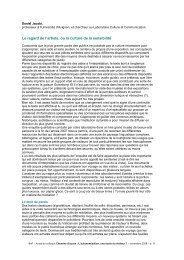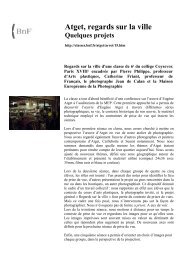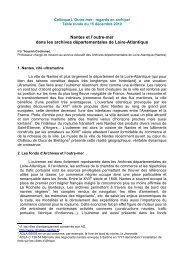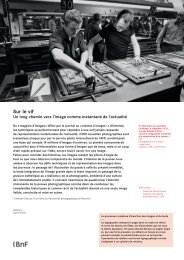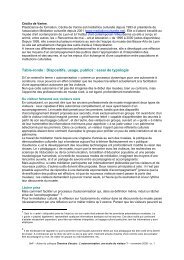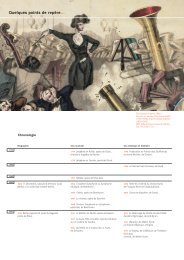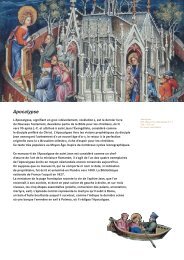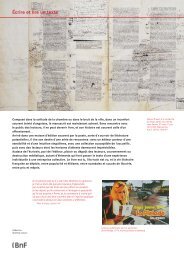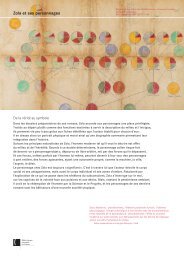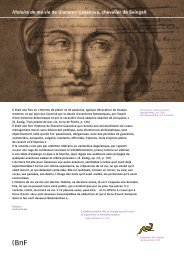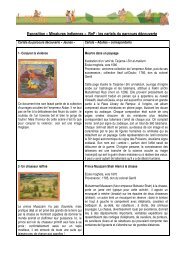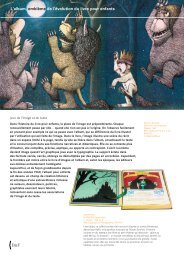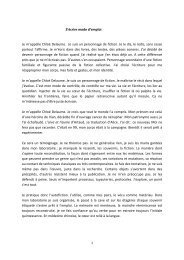La lecture au jour le jour : les quotidiens à l'âge d'or de la presse - BnF
La lecture au jour le jour : les quotidiens à l'âge d'or de la presse - BnF
La lecture au jour le jour : les quotidiens à l'âge d'or de la presse - BnF
You also want an ePaper? Increase the reach of your titles
YUMPU automatically turns print PDFs into web optimized ePapers that Google loves.
Les fou<strong>le</strong>s <strong>de</strong> <strong>le</strong>cteurs, Le Petit Journal (1863-1944), Le Petit Parisien (1876-1944),<br />
Le Matin (1884-1944), Le Journal (1892-1944)<br />
Les petits <strong>jour</strong>n<strong>au</strong>x <strong>de</strong>viennent<br />
<strong>le</strong>s plus grands <strong>de</strong> tous<br />
<strong>La</strong>ncé en 1863 par Moïse Mill<strong>au</strong>d, Le Petit<br />
Journal reprend certaines <strong>de</strong>s recettes<br />
inventées par Girardin mais <strong>à</strong> une tout <strong>au</strong>tre<br />
échel<strong>le</strong>. Ce quotidien non politique, qui se veut<br />
lui <strong>au</strong>ssi un <strong>jour</strong>nal purement d’information,<br />
vise un <strong>le</strong>ctorat encore plus <strong>la</strong>rge que celui<br />
<strong>de</strong> <strong>La</strong> Presse. Mill<strong>au</strong>d diminue <strong>de</strong> moitié <strong>le</strong> prix<br />
du <strong>jour</strong>nal en <strong>le</strong> fixant <strong>à</strong> 5 centimes (un sou),<br />
<strong>la</strong> plus petite pièce <strong>de</strong> monnaie <strong>de</strong> l’époque<br />
– <strong>au</strong> lieu <strong>de</strong>s 10 <strong>à</strong> 15 centimes <strong>de</strong>s <strong>quotidiens</strong><br />
existants. <strong>La</strong> diffusion du <strong>jour</strong>nal se fait<br />
principa<strong>le</strong>ment par <strong>la</strong> vente <strong>au</strong> numéro et non<br />
plus par abonnement comme avant. Le succès<br />
est triomphal : en <strong>de</strong>ux ans, <strong>le</strong>s tirages du<br />
Petit Journal passent <strong>de</strong> 38 000 exemp<strong>la</strong>ires<br />
<strong>à</strong> 250 000. Sa réussite eut pour conséquence<br />
immédiate <strong>la</strong> multiplication <strong>de</strong> formu<strong>le</strong>s<br />
concurrentes, Le Petit Parisien est créé en<br />
1876, puis Le Matin en 1884 et Le Journal en<br />
1892. Ces « petits » <strong>jour</strong>n<strong>au</strong>x intègrent toutes<br />
<strong>le</strong>s avancées <strong>de</strong>s révolutions techniques,<br />
impression – <strong>le</strong>s rotatives, y compris, <strong>à</strong> partir<br />
<strong>de</strong> 1889, en cou<strong>le</strong>urs –, transports, <strong>le</strong> chemin<br />
<strong>de</strong> fer et l’<strong>au</strong>tomobi<strong>le</strong>. Pour pouvoir vendre<br />
suffisamment, <strong>le</strong>s <strong>jour</strong>n<strong>au</strong>x doivent disposer<br />
d’un grand nombre <strong>de</strong> points <strong>de</strong> vente et<br />
s’assurer <strong>de</strong> <strong>le</strong>ur bon approvisionnement.<br />
Or ces <strong>jour</strong>n<strong>au</strong>x fabriqués <strong>à</strong> Paris veu<strong>le</strong>nt<br />
toucher une clientè<strong>le</strong> nationa<strong>le</strong>. En 1911<br />
Le Petit Journal diffuse 80 % <strong>de</strong> son tirage<br />
en province. Ces <strong>jour</strong>n<strong>au</strong>x impriment donc<br />
plusieurs éditions, en 1914 Le Petit Parisien en<br />
possè<strong>de</strong> sept. Très rapi<strong>de</strong>ment, ces <strong>quotidiens</strong><br />
sont donc <strong>de</strong>venus <strong>de</strong>s géants <strong>de</strong> <strong>la</strong> <strong>presse</strong>,<br />
en diffusant <strong>de</strong>s millions d’exemp<strong>la</strong>ires.<br />
L’invention <strong>de</strong> <strong>la</strong> une<br />
Ce qui change très rapi<strong>de</strong>ment est <strong>la</strong> mise<br />
en page : vendus <strong>au</strong> numéro, ces <strong>quotidiens</strong><br />
popu<strong>la</strong>ires doivent attirer <strong>le</strong> <strong>le</strong>cteur. Ils<br />
inventent un titre ban<strong>de</strong><strong>au</strong> sur toute <strong>la</strong> <strong>la</strong>rgeur<br />
<strong>de</strong> <strong>la</strong> première page, sous <strong>la</strong> manchette du titre<br />
du <strong>jour</strong>nal, ce qui facilite <strong>la</strong> vente <strong>à</strong> <strong>la</strong> criée.<br />
Mais ce titre « reste en l’air » (Gil<strong>le</strong>s Feyel),<br />
ne coiffe pas l’artic<strong>le</strong>, et parfois l’événement<br />
annoncé n’est traité que par un court entrefi<strong>le</strong>t<br />
en troisième page. C’est avec Le Matin que<br />
s’opère une révolution dans <strong>la</strong> présentation<br />
du <strong>jour</strong>nal. On note une actualisation <strong>de</strong><br />
<strong>la</strong> première page, <strong>de</strong>venue véritab<strong>le</strong> « une »,<br />
par <strong>la</strong> mise en va<strong>le</strong>ur <strong>de</strong> tel ou tel événement<br />
<strong>de</strong> l’actualité immédiate. Les faits divers,<br />
qui se trouvent dans <strong>le</strong>s anciens <strong>quotidiens</strong><br />
uniquement dans <strong>le</strong>s pages intérieures, souvent<br />
vers <strong>la</strong> fin du <strong>jour</strong>nal, arrivent en première page<br />
et <strong>la</strong> publicité « remonte » el<strong>le</strong> <strong>au</strong>ssi.<br />
Le <strong>jour</strong>nal, « un régal matinal »<br />
Outre <strong>la</strong> présentation <strong>de</strong>s artic<strong>le</strong>s, c’est <strong>le</strong><br />
sty<strong>le</strong> même qui se transforme. De nouvel<strong>le</strong>s<br />
formes d’écriture, <strong>le</strong>s dépêches, apparaissent<br />
dans Le Matin, <strong>le</strong> <strong>jour</strong>nal <strong>le</strong> plus influencé par<br />
<strong>la</strong> <strong>presse</strong> américaine. Ses <strong>jour</strong>nalistes doivent<br />
apprendre <strong>à</strong> écrire plus court, <strong>à</strong> privilégier<br />
<strong>le</strong> factuel – <strong>le</strong>s « news » – <strong>au</strong> détriment <strong>de</strong>s<br />
analyses et <strong>de</strong>s commentaires – <strong>le</strong>s « views ».<br />
Cette mise en forme très courte <strong>de</strong> l’information<br />
est supposée correspondre <strong>à</strong> une nouvel<strong>le</strong><br />
forme <strong>de</strong> <strong><strong>le</strong>cture</strong> du <strong>jour</strong>nal qui s’apparente plus<br />
<strong>à</strong> <strong>la</strong> consommation d’un produit alimentaire.<br />
Cette comparaison revient fréquemment dans<br />
<strong>le</strong>s textes <strong>de</strong>s contemporains. Le <strong>jour</strong>naliste<br />
Étienne Groscl<strong>au</strong><strong>de</strong> se moque <strong>de</strong>s 750 000<br />
vieil<strong>le</strong>s dames « qui ont coutume <strong>de</strong> tremper,<br />
chaque matin, Le Petit Journal dans <strong>le</strong>ur café<br />
<strong>au</strong> <strong>la</strong>it ». Marcel Proust souligne l’ambiguïté<br />
<strong>de</strong> cette nouvel<strong>le</strong> pratique <strong>de</strong> <strong><strong>le</strong>cture</strong> et écrit :<br />
« Procé<strong>de</strong>r <strong>à</strong> cet acte abominab<strong>le</strong> et voluptueux<br />
qui s’appel<strong>le</strong> lire <strong>le</strong> <strong>jour</strong>nal et grâce <strong>au</strong>quel<br />
tous <strong>le</strong>s malheurs et cataclysmes <strong>de</strong> l’univers<br />
pendant <strong>le</strong>s <strong>de</strong>rnières vingt-quatre heures […]<br />
transmués pour notre usage personnel <strong>à</strong> nous<br />
qui n’y sommes pas intéressés, en un régal<br />
matinal, s’associent excel<strong>le</strong>mment, d’une<br />
façon singulièrement excitante et tonique,<br />
<strong>à</strong> l’ingestion recommandée <strong>de</strong> quelques<br />
gorgées <strong>de</strong> café.<br />
Des <strong>jour</strong>n<strong>au</strong>x pour tous<br />
Les <strong>le</strong>cteurs sont non seu<strong>le</strong>ment <strong>le</strong>s nouve<strong>au</strong>x<br />
<strong>le</strong>cteurs que Girardin avait voulu séduire :<br />
ouvriers <strong>de</strong>s f<strong>au</strong>bourgs, artisans du vil<strong>la</strong>ge,<br />
paysans, employés, mais <strong>au</strong>ssi tous <strong>le</strong>s <strong>au</strong>tres<br />
<strong>le</strong>cteurs. Le triomphe <strong>de</strong> <strong>la</strong> <strong>presse</strong> popu<strong>la</strong>ire,<br />
p<strong>le</strong>ine <strong>de</strong> crimes et <strong>de</strong> nouvel<strong>le</strong>s <strong>à</strong> sensation,<br />
se vérifie <strong>de</strong> <strong>jour</strong> en <strong>jour</strong> <strong>au</strong>x dépens d’une<br />
<strong>presse</strong> politique plus <strong>au</strong>stère. De fait certains<br />
<strong>quotidiens</strong> comme Le Journal <strong>de</strong>s débats ne<br />
font que se maintenir pénib<strong>le</strong>ment dans ce<br />
nouve<strong>au</strong> contexte. Pour <strong>au</strong>tant <strong>la</strong> <strong><strong>le</strong>cture</strong> <strong>de</strong><br />
<strong>la</strong> <strong>presse</strong> popu<strong>la</strong>ire ne remp<strong>la</strong>ce pas <strong>la</strong> <strong><strong>le</strong>cture</strong><br />
<strong>de</strong>s <strong>au</strong>tres <strong>jour</strong>n<strong>au</strong>x. Au contraire, pour <strong>le</strong>s<br />
<strong>le</strong>cteurs « c<strong>la</strong>ssiques », cette <strong>presse</strong> semb<strong>le</strong><br />
s’ajouter <strong>au</strong>x <strong>au</strong>tres. Ce nouve<strong>au</strong> mo<strong>de</strong> <strong>de</strong><br />
consommation <strong>de</strong> l’information touche tout<br />
<strong>le</strong> mon<strong>de</strong>, comme l’écrit Émi<strong>le</strong> Zo<strong>la</strong> : « Je me<br />
souviens <strong>de</strong> mon grand-père, <strong>de</strong> quel<strong>le</strong> façon<br />
<strong>le</strong>nte et convaincue il s’instal<strong>la</strong>it dans son<br />
f<strong>au</strong>teuil pour lire son <strong>jour</strong>nal il y mettait bien<br />
trois ou quatre heures. […] Au<strong>jour</strong>d’hui, que<br />
<strong>le</strong>s choses ont changé ! On ouvre un <strong>jour</strong>nal,<br />
on <strong>le</strong> parcourt, on <strong>le</strong> jette. […] Et ce n’est<br />
plus un <strong>jour</strong>nal, c’est quatre, c’est cinq,<br />
davantage <strong>le</strong>s matins <strong>de</strong> crise, qu’on achète<br />
et qu’on froisse lorsqu’on a lu <strong>le</strong>s vingt lignes<br />
intéressantes. Tout va <strong>au</strong> ruisse<strong>au</strong>, <strong>le</strong>s rues<br />
charrient du papier piétiné, maculé par nos<br />
fièvres du <strong>jour</strong>. »<br />
Un nouve<strong>au</strong> régime <strong>de</strong> l’opinion<br />
Cette <strong>presse</strong> popu<strong>la</strong>ire, si el<strong>le</strong> profite <strong>de</strong>s<br />
avancées techniques très rapi<strong>de</strong>s <strong>de</strong> <strong>la</strong> fin<br />
du xix e sièc<strong>le</strong>, bénéficie surtout <strong>de</strong>s progrès<br />
<strong>de</strong> <strong>la</strong> sco<strong>la</strong>risation. Il f<strong>au</strong>t environ, comme<br />
l’écrit Gil<strong>le</strong>s Feyel, « une trentaine d’années<br />
– <strong>le</strong> temps d’une génération – entre <strong>la</strong> création<br />
<strong>de</strong> l’éco<strong>le</strong> <strong>au</strong> vil<strong>la</strong>ge et <strong>la</strong> pénétration <strong>de</strong> <strong>la</strong><br />
<strong>presse</strong>, messagère <strong>de</strong>s vil<strong>le</strong>s. […] Le <strong>jour</strong>nal<br />
a souvent été <strong>le</strong> prolongement <strong>de</strong> l’éco<strong>le</strong> ».<br />
Les <strong>quotidiens</strong> nés dans <strong>le</strong>s années 1880<br />
et 1890 ont donc récolté <strong>le</strong>s fruits du long<br />
processus <strong>de</strong> création d’éco<strong>le</strong>s <strong>de</strong>puis <strong>le</strong>s<br />
lois Guizot jusqu’<strong>au</strong>x lois <strong>de</strong> Ju<strong>le</strong>s Ferry.<br />
Cet immense <strong>le</strong>ctorat qui regroupe presque<br />
toute <strong>la</strong> popu<strong>la</strong>tion adulte française dépasse<br />
en nombre, sous <strong>le</strong> régime du suffrage<br />
universel masculin, celui <strong>de</strong>s citoyens.<br />
Le déclin après <strong>la</strong> Première Guerre<br />
mondia<strong>le</strong><br />
Cette h<strong>au</strong>sse du <strong>le</strong>ctorat <strong>au</strong> début du<br />
xx e sièc<strong>le</strong> s’arrête après <strong>la</strong> Première Guerre<br />
mondia<strong>le</strong> : <strong>le</strong>s tirages diminuent drastiquement<br />
<strong>au</strong> début <strong>de</strong>s années 1930. Les <strong>le</strong>cteurs<br />
commencent <strong>à</strong> écouter <strong>la</strong> radio, se tournent<br />
vers <strong>de</strong> nouve<strong>au</strong>x <strong>jour</strong>n<strong>au</strong>x comme Paris-Soir<br />
et achètent <strong>de</strong>s <strong>jour</strong>n<strong>au</strong>x plus politisés, situés<br />
tant <strong>à</strong> l’extrême droite qu’<strong>à</strong> l’extrême g<strong>au</strong>che,<br />
<strong>à</strong> l’unisson <strong>de</strong>s luttes viru<strong>le</strong>ntes <strong>de</strong>s années<br />
1930. À cette époque, <strong>le</strong>s « quatre grands » sont<br />
tous favorab<strong>le</strong>s <strong>à</strong> <strong>la</strong> droite et hosti<strong>le</strong>s <strong>au</strong> Front<br />
popu<strong>la</strong>ire. Enfin, en province, be<strong>au</strong>coup <strong>de</strong><br />
<strong>le</strong>cteurs lisent <strong>la</strong> <strong>presse</strong> quotidienne régiona<strong>le</strong><br />
qui propose <strong>de</strong>s <strong>jour</strong>n<strong>au</strong>x moins chers et plus<br />
proches <strong>de</strong> <strong>le</strong>urs centres d’intérêt.<br />
Les manchettes du Petit Journal (1863-<br />
1944), du Petit Parisien (1876-1944)<br />
et du Journal (1892-1944) : ces <strong>jour</strong>n<strong>au</strong>x<br />
sont entièrement numérisés sur Gallica.<br />
Le Petit Journal et Le Petit Parisien ont abandonné<br />
<strong>le</strong>ur <strong>de</strong>mi-format initial (300 µ 430 mm) <strong>au</strong> début<br />
<strong>de</strong>s années 1890 pour adopter <strong>le</strong> grand format<br />
(600 µ 445 mm). Le nombre <strong>de</strong> pages <strong>au</strong>gmente<br />
en parallè<strong>le</strong> : 4 puis 6 dans <strong>le</strong>s années 1890,<br />
puis 8 <strong>à</strong> 12 selon <strong>le</strong>s <strong>jour</strong>s <strong>de</strong> <strong>la</strong> semaine en 1914.<br />
En 1902, date <strong>de</strong> réalisation <strong>de</strong> ces cartes posta<strong>le</strong>s,<br />
Le Petit Journal, Le Petit Parisien et Le Matin sont<br />
tous sur 6 pages, Le Journal est sur 8.<br />
Procé<strong>de</strong>r <strong>à</strong> cet acte abominab<strong>le</strong> et voluptueux qui s’appel<strong>le</strong> lire <strong>le</strong> <strong>jour</strong>nal et grâce <strong>au</strong>quel<br />
tous <strong>le</strong>s malheurs et cataclysmes <strong>de</strong> l’univers pendant <strong>le</strong>s <strong>de</strong>rnières vingt-quatre heures<br />
[…] transmués pour notre usage personnel <strong>à</strong> nous qui n’y sommes pas intéressés, en un<br />
régal matinal, s’associent excel<strong>le</strong>mment, d’une façon singulièrement excitante et tonique,<br />
<strong>à</strong> l’ingestion recommandée <strong>de</strong> quelques gorgées <strong>de</strong> café <strong>au</strong> <strong>la</strong>it.<br />
Marcel Proust, 1919



